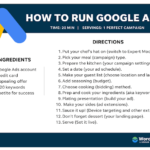In the fast-paced world of digital marketing, driving traffic to your website is only the first step. The real challenge lies in converting that traffic into tangible results, whether it’s sales, leads, or sign-ups. This is where conversion rate optimization (CRO) comes into play. CRO is the process of increasing the percentage of website visitors who complete a desired action, such as making a purchase or subscribing to a service.
For beginners, mastering CRO can feel daunting, but the rewards are well worth the effort. By optimizing your website for conversions, you can dramatically improve your return on investment (ROI), make the most of your marketing budget, and enhance the overall user experience. In this beginner’s guide, we’ll walk you through the basics of CRO and provide actionable tips to get you started.
What is Conversion Rate Optimization?
At its core, conversion rate optimization is about making the most of the traffic you already have. Instead of focusing solely on increasing the number of visitors to your website, CRO aims to maximize the value of each visitor by encouraging them to take specific actions.
The conversion rate is calculated by dividing the number of conversions by the total number of visitors and multiplying by 100. For example, if 100 people visit your site and 5 of them make a purchase, your conversion rate is 5%.
CRO helps improve this rate by optimizing various elements of your website, such as the design, content, and user experience, to make it easier for visitors to convert.
Common Types of Conversions
Conversions vary depending on the goals of your business. Some common types of conversions include:
- Sales: The most common conversion for e-commerce websites.
- Lead generation: Capturing contact information through forms.
- Sign-ups: Encouraging users to sign up for newsletters, webinars, or accounts.
- Downloads: Getting visitors to download eBooks, white papers, or other resources.
Why is CRO Important?
CRO is essential because it enables businesses to make the most out of their existing traffic. Instead of spending more on paid advertising to increase traffic, CRO focuses on improving the effectiveness of your website, helping you convert more visitors into customers or leads.
Here are some key benefits of CRO:
Improved ROI
The most significant benefit of CRO is an improved return on investment (ROI). By increasing the percentage of visitors who convert, you can generate more revenue without increasing your marketing budget.
Cost-Efficient Growth
Acquiring new customers through advertising can be expensive. CRO allows you to grow your business by making the most of the traffic you already have, leading to cost-efficient growth.
Enhanced User Experience
CRO focuses on improving the user experience by making your website easier to navigate and more intuitive. Happy visitors are more likely to convert, and a positive user experience can lead to increased customer loyalty and word-of-mouth referrals.
Competitive Advantage
A well-optimized website can give you a competitive edge in the marketplace. If your website converts better than your competitors, you’ll be able to grow your market share and generate more revenue with the same level of traffic.
Understanding Your Audience: The Foundation of CRO
Before you can start optimizing your website, you need to understand your audience and their behavior. Knowing what motivates visitors, what obstacles they face, and what persuades them to take action is crucial for CRO success.
Tools to Understand Audience Behavior:
- Google Analytics: This tool provides detailed insights into user behavior, including which pages they visit, how long they stay, and where they drop off.
- Heatmaps (e.g., Hotjar or Crazy Egg): Heatmaps visualize where users click, scroll, and spend time on your website, helping you identify areas of interest or frustration.
- Session Recordings: These tools allow you to watch recordings of real users navigating your site, giving you a firsthand look at their behavior.
Key Metrics to Track:
- Bounce rate: The percentage of visitors who leave your site without interacting with it.
- Exit rate: The percentage of visitors who leave from a specific page.
- Conversion rate: The percentage of visitors who complete the desired action (e.g., purchase, sign-up).
- User flow: The path that users take to navigate through your website.
By gathering and analyzing this data, you can identify problem areas, test hypotheses, and implement changes that directly address the needs of your visitors.
Best Practices for CRO: Actionable Tips
Now that you have a solid understanding of CRO and your audience, it’s time to start optimizing your website. Below are some of the most effective CRO strategies for beginners.
Optimize Your Landing Pages
Your landing pages are often the first point of contact between your business and potential customers, so they must be optimized for conversions. A great landing page should be clear, concise, and focused on a single goal.
- Clear value proposition: Clearly explain the benefits of your product or service and why visitors should care.
- Strong call to action (CTA): Your CTA should be prominently displayed, using action-oriented language like “Buy Now,” “Sign Up,” or “Get Started.”
- Relevant content: Make sure the content on your landing page matches the intent of the visitors who arrive there. If they’re coming from an ad, ensure the page fulfills the promise made in that ad.
Simplify the User Journey
A complicated user journey with too many steps can lead to high drop-off rates. Simplify the process by reducing unnecessary steps and making it easy for users to complete the desired action.
- Minimize form fields: If you’re collecting information from users, ask for only what’s essential. Long forms can deter visitors from completing them.
- Streamline checkout process: For e-commerce sites, remove any friction from the checkout process by offering guest checkout, displaying progress indicators, and providing multiple payment options.
A/B Testing: The Key to Continuous Improvement
A/B testing involves creating two different versions of a page or element and testing them against each other to see which one performs better. A/B testing allows you to make data-driven decisions and continuously improve your conversion rate.
- Headlines: Test different headlines to see which ones grab users’ attention and communicate value more effectively.
- Call-to-action buttons: Experiment with different CTA designs, colors, and text to see what drives the most conversions.
- Images and media: Test different images, videos, or graphics to determine which visuals resonate most with your audience.
Use Social Proof to Build Trust
Social proof is a powerful psychological motivator. People are more likely to trust and engage with your business if they see that others have had positive experiences with it. Incorporating social proof can help increase your credibility and conversion rate.
- Customer reviews and testimonials: Showcase positive feedback from satisfied customers.
- Trust badges and certifications: Display badges from recognized organizations or secure payment certifications to build trust.
- Case studies: Share success stories from your customers to demonstrate the value of your products or services.
Mobile Optimization: Don’t Overlook Mobile Users
With the majority of internet traffic coming from mobile devices, ensuring that your website is mobile-friendly is essential for CRO. Mobile users expect a seamless experience, so make sure your site is optimized for smaller screens.
- Responsive design: Ensure your website adjusts to fit any screen size without sacrificing usability.
- Simplified navigation: Keep menus, buttons, and forms easy to use on mobile devices.
- Fast loading times: Mobile users are more likely to leave if your site takes too long to load, so prioritize speed.
Tracking and Analyzing Your CRO Efforts
Once you’ve implemented CRO strategies, it’s important to track and measure the results. Use tools like Google Analytics, A/B testing platforms, and heatmap tools to monitor the impact of your changes.
Key Metrics to Track:
- Conversion rate: Did your changes lead to an increase in the percentage of visitors converting?
- Engagement metrics: Are users spending more time on your site or interacting with key elements?
- Bounce rate: Are fewer users leaving without engaging?
- Revenue per visitor (RPV): How much revenue are you generating for each visitor?
By continually testing and analyzing your website’s performance, you can refine your CRO strategy and achieve long-term success.
Conclusion
Mastering conversion rate optimization (CRO) is a critical step for maximizing your ROI and growing your business. By focusing on understanding your audience, optimizing key elements of your website, and continuously testing and improving, you can turn more visitors into customers and increase your revenue without significantly increasing your traffic.
CRO is an ongoing process, and even small changes can have a big impact on your bottom line. As you become more familiar with CRO tools and strategies, you’ll be able to make data-driven decisions that enhance your website’s performance and boost your ROI.


